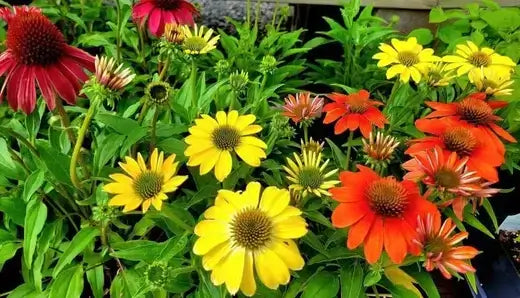Pruning and deadheading are essential to maintaining a healthy and vibrant perennial garden
These two techniques involve removing specific parts of the plant, such as stems, flowers, or foliage, and they offer numerous benefits that contribute to the overall well-being and aesthetics of the garden.
Perennial Package 10 Purple & Gold PerennialsBy cutting back overgrown or damaged branches, pruning helps promote a more compact and well-balanced plant form. It improves the garden's appearance, creating a neat and visually appealing landscape. In addition to shaping the plants, pruning also stimulates new growth.
By removing old or spent branches, the plant's energy is redirected to the remaining healthy parts, encouraging the development of fresh, vigorous shoots and foliage. This results in a more lush and abundant garden with increased flowering and a longer blooming period. Blue Flag Iris is easy to maintain.
Pruning also enhances air circulation and sunlight penetration within the plant canopy
Removing dense or overcrowded branches allows air to flow more freely, reducing the risk of fungal diseases and promoting better overall plant health. Improved sunlight exposure enables the plant to undergo photosynthesis more efficiently, enhancing its energy production and supporting robust growth.
Another critical aspect of maintaining a perennial garden is deadheading, which involves the removal of spent flowers. Deadheading serves multiple purposes and has several significant benefits. It enhances the visual appeal of the park by eliminating faded or withered flowers, ensuring that the garden looks fresh and vibrant throughout the season.
Deadheading also prevents the formation of seeds, redirecting the plant's energy toward producing new blooms instead. It encourages extended flowering and helps the plant focus its resources on further growth and development. Moreover, deadheading can help prevent self-seeding and invasiveness.
Many perennial plants tend to self-sow and spread rapidly if their seeds are allowed to mature and disperse. By removing the spent flowers before seed formation, deadheading helps maintain control over the garden's design and prevents the proliferation of unwanted or invasive plants.
Furthermore, deadheading supports the overall health and vitality of the perennial garden. Removing spent flowers reduces the risk of fungal diseases and pest infestations since decaying flowers can attract pathogens and pests. Additionally, pulling spent blooms prevents the plant from expending energy on seed production, allowing it to allocate resources to essential processes like root growth, nutrient absorption, and winter preparation.
It is important to note that pruning and deadheading techniques should be applied correctly and appropriately to avoid harming the plants. Different perennial species may have specific pruning requirements, and it is crucial to understand the particular needs of each plant in your garden.
Proper tools, such as sharp and clean pruning shears, should ensure clean cuts and minimize the risk of disease transmission. In conclusion, pruning and deadheading in perennial gardening cannot be overstated. These practices contribute significantly to the garden's health, appearance, and longevity. If you have too much water in your garden, Blue Lobelia is the way to go!
Pruning promotes well-structured growth, stimulates new shoots, and enhances air circulation and sunlight exposure
Deadheading improves the garden's visual appeal, prolongs flowering, prevents self-seeding, and supports overall plant health. By incorporating these techniques into regular garden maintenance, gardeners can enjoy a beautiful, flourishing perennial garden year after year.
Tn Nursery https://www.tnnursery.net




